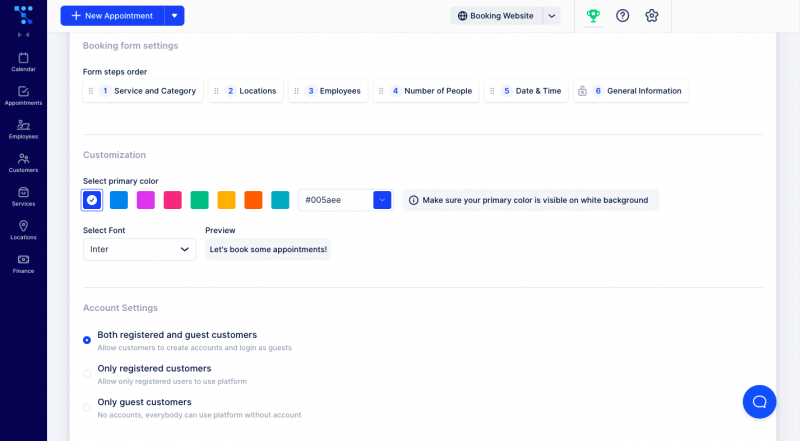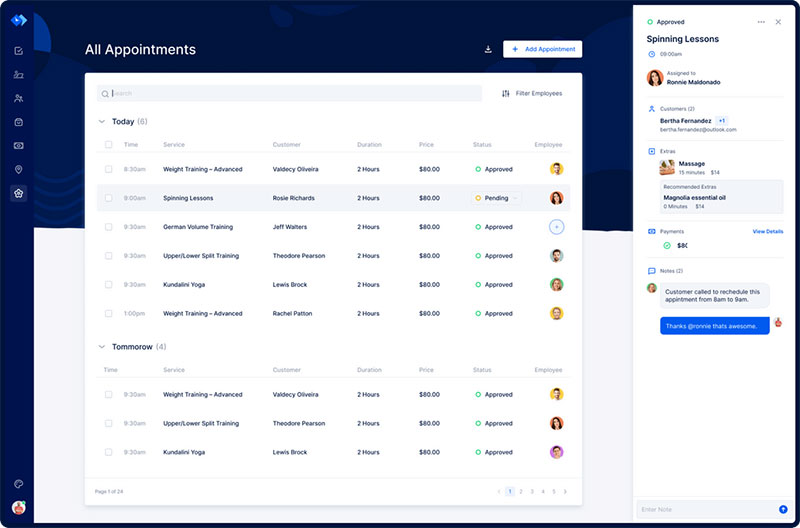Starting a dog walking business can be a fairly straightforward process, as well as a great low-cost way to enter the general animal industry. But just like any type of new business endeavor, there will be a difficult process of gaining clientele as well as making your business profitable during the first few months.
Figuring out how to start a dog walking business won’t be easy. You will need to start by considering some specific circumstances in the the dog walking industry, like buying supplies or driving to and from your customers.
If you are thinking about whether or not you want to start a dog walking business, keep reading to find some great information on the industry as a whole and some helpful tips on how to start a dog walking business correctly.
What Does a Dog Walker Do?

Most people have an idea about what dog walkers do, but there are many things that a dog walker has to do that are forgotten. The most important thing to consider is the responsibility they take on for the dogs they are taking care of. This means that they need to be insured and bonded by an insurance company and know pet first aid in case of emergencies.
No matter what the task, it’s important to stay professional. This means that you should always arrive on time and complete your contract. This also means that often you may need to work weekends or holidays. In fact, holidays are often the busiest times of the year for pet sitters.
Some Tips for How to Start a Dog Walking Business
Just like all small businesses, you will need to make some financial decisions before you start your dog walking business.
You will also have to juggle walking dogs with your administrative tasks. But before you are bogged down with details, consider some necessary information about starting a dog walking business.
First, get a scheduling software to streamline your calendar
Staying organized has never been easier.
You can now manage your business and grow your brand with a single, powerful software that keeps all of your appointments in line, your clients organized and your business booming.
Trafft is perfect for business owners who need to streamline their booking experience both for their staff and their clients.
Trafft handles everything for you, even sending automated email or SMS reminders to your clients. No-shows? Not anymore!
The Trafft booking software adapts to different industries for a blissful online booking experience and employee management.
https://www.youtube.com/watch?v=aGbUg7PVtLk
Want to know more? Check out Trafft’s awesome features to see what you are missing.
Scheduling software that works for your dog walking business will make your life easier. It will also help expand your business and elevate your clients’ experience.
Using Trafft’s appointment and booking software will greatly help you set up your working hours as well as allow your clients to schedule your pet sitter services online.

The following are some examples of how Trafft can help:
- It can monitor how well your business performs.
- It allows you to set working days, vacation days, and special events.
- It lets you get comprehensive analytics on your business.
- It helps you set a price for your pet sitter services, as well as format it for your employees, if you have them.
- It lets you manage appointments through a centralized online calendar, set free time for new appointments,
- and much more!
Know Your Target Market
If you want to start a dog walking business successfully, you have to find your target audience. So, ask yourself “Who needs their dog walked?”. The simple answer is all dog owners. Dogs need fresh air, especially high-energy dogs. A large portion of potential clients will fit into one of these three groups:
- The Frequent Travelers
- The Elderly
- And the Business Professionals
This does not include everyone, all dog owners who work away from home could use your dog walking services. But your ideal customer is concerned about their pet being alone for an extended period of time and has the money to pay for your dog walking services.
Structure Your Small Business
The majority of dog walking businesses are structured as sole proprietorships or limited liability companies (LLCs). Both have pros and cons and should be considered before you start a dog walking business. As a sole proprietor, you are the only (sole) owner (proprietor) of your business. This means that you make all decisions, but it also means that you take on all expenses.
LLCs, on the other hand, separate your personal and business assets. This means that you won’t be liable for the debts of the business, but it can also be a hassle to run.
Secure the Necessary Business Licenses
Becoming a certified dog walker is not necessary for your dog walking business, but it’s worth considering. Having a dog walking certificate can help show that you are legit and committed to your business.
You also need to get a business license from the government. It may seem superfluous at times when you are only walking dogs for a couple of people, but it’s actually necessary. Try doing some research to see what are the laws about the size of your business and which license you need to obtain.
Assess the Local Dog Walking Business Landscape
You probably know the phrase “supply and demand”. It applies to almost all industries, and dog walking is no different. Whatever the “demand” is in a specific area determines how much “supply” the area should receive.
The higher the demand and the lower the supply of dog walking businesses, the more you can charge. This also means that if there are an abundance of companies from which potential clients can choose, dog walking businesses will have to lower their prices to compete with each other.
So, when choosing where you want to start a dog walking business, don’t choose an area that’s oversaturated with dog walking businesses. Instead, try to find an area that has few dog walkers and plenty of clients.
Price Your Services Correctly
The amount that you earn is based directly on how many dogs you walk, but that’s not all that you can do. Many professional dog walkers charge more for additional services to increase their revenue.
The following are some of the main factors you should consider before setting your price:
- What is your competition charging?
- Where are you located?
- What services will you offer?
- How much do you want/need to make to sustain your workers and business?
- What are your expenses?
Fees are based on the specific services needed by each client/dog. On average, professionals charge $15- $17 for a 15 – 20 minute walk and $18 – $22 for a 30 – 40 minute walk. For a 40 – 60 minute walk, you could charge between $22 and $27.
Make sure you let your clients know the prices in a clear and easy-to-understand way. If you do so, you will be more reliable and have fewer misunderstandings about pricing.
Obtain Dog Walking Insurance
Again, it may seem unnecessary to get dog walking insurance when you are only working with a couple of dogs, but you are responsible for those dogs. Dog walking business insurance is a definite must-have. Also, you will need general liability insurance so that you can be protected against injuries caused. Dog walking insurance will help your company be safe from lawsuits.
Also, if you are running your business from a house, you will need to be insured for the property.
Promote Yourself
If you want to succeed you will need to bring customers to your dog walking business, and what better way than finding a good online marketing strategy. You can do this by making a business website. Then, you can use that website on your social media platforms to help attract customers.
It’s also important to remember the power of word-of-mouth marketing. Whenever you get a new client, ask where they learned about your company. This will help you to know where you should focus your efforts.
The Financials
It may seem like starting a dog walking business has no start-up prices, but that isn’t entirely true. You would be surprised to find what it takes to get started, here’s a list.
- Dog Walking Supplies — $5+
- Taking a Pet First Aid Class — $50 to $200+
- Creating Marketing Materials — $10+
- Building a Website— $15 to $50+
- Obtaining Professional Pet Care Insurance — $129+
- Joining Professional Organizations — $0 to $300+
- Obtaining a Business License — $0 to $400+
- Opening a Business Bank Account — $0 to varies
- Registering Your Business as an LLC or DBA— $10 to $500
Choose a Name and Logo
When you start your dog walking business, you need to think about branding. Your name and logo identify you, and they are what possible clients will remember. It should represent the personality of your dog walking business.
This may not be as simple as you think. When naming a business, you want it to be short, concise, and easy to remember. In some areas, you may also need to register or receive approval from local or state governments.
Obtain Signed Contracts
You should always try to work with signed contracts. This helps show the relationship between you and your dog walking clients. Make sure that you are specific with what isn’t or is part of the contract.
The following are some examples of what your contracts should include:
- A Vet Release Form is designed to provide your business with the authorization to seek medical care for the pets in your care in case of an emergency.
- A Service Provider Agreement will describe all the services that you will provide to a client.
- A Payment Authorization Form is important for when it’s time to take payments.
- A Key Handling Form is essential when you are dealing with lots of clients with lots of keys.
FAQs about starting a dog walking business
1. What are the legal requirements for starting a dog walking business in my area?
Depending on where you live, there may be different legal requirements for launching a dog walking service. Normally, you must register your company with your local government, receive any appropriate licenses or permissions, and adhere to any zoning or animal control laws.
To make sure you’re running your business legally and responsibly, it’s crucial to learn about and adhere to these standards.
2. How much should I charge for dog walking services?
It’s vital to take into account aspects like the length of the walk, the number of dogs, and local competition when determining how much to charge for dog walking services.
To get a sense of what other dog walkers are charging in your area, you may also look up local prices. Numerous dog walkers bill by the hour or provide packages for multiple weekly walks.
3. Do I need to have any certifications or training to start a dog walking business?
Although there aren’t any particular licenses needed to start a dog walking business, it’s a good idea to have some training or prior dog-handling experience. This can include instruction in dog safety and behavior as well as hands-on training with dogs.
Possessing this information and expertise will enable you to better serve your customers and guarantee the security of the dogs under your care.
4. How do I attract and retain clients for my dog walking business?
You can employ a range of marketing techniques, including social media marketing, local publication advertising, and networking with other pet industry experts, to draw in and keep customers for your dog walking business.
You can retain customers and establish a good reputation for your organization by offering exceptional customer service and fostering client connections.
5. What kind of insurance do I need to protect myself and my clients?
Liability insurance is essential to safeguard both you and your consumers in case of mishaps or injuries. To guard against theft and other monetary losses, you might also wish to think about getting bonding insurance. To find the finest insurance for your company, make sure to investigate and evaluate your possibilities.
6. How do I handle emergencies or accidents while dog walking?
It’s crucial to have a plan in place to address emergencies or mishaps while dog walking. This can involve keeping a first aid kit on hand, knowing how to get emergency veterinary services, and formulating a plan for informing customers and emergency contacts.
7. How many dogs can I walk at one time?
The number of dogs you can walk at once will rely on both your talents and the temperament of the dogs. Prioritize safety and refrain from taking on more dogs than you can manage. A lot of dog walkers only take three or four dogs out at a time.
8. What equipment do I need to start a dog walking business?
Leashes, collars, waste bags, and potentially a vehicle for transportation are among the supplies required to start a dog walking business. It’s crucial to spend money on sturdy, safe equipment for the dogs under your care.
9. How do I create a schedule for dog walking and manage my time effectively?
Running a successful dog walking business requires planning your dog walks ahead of time and properly managing your time. You may efficiently plan your journeys and keep track of appointments by using scheduling software or applications. Also, it’s critical to have a fallback strategy in place in case of last-minute cancellations or schedule modifications.
10. How do I handle difficult or aggressive dogs while dog walking?
It can be tough to control demanding or aggressive dogs while dog walking. It’s crucial to have a strategy in place for dealing with such circumstances, including avoiding particular dogs or locations, employing positive reinforcement training methods, and having a backup plan for emergencies.
To learn more about training challenging dogs, you might also want to think about taking on more training or consulting with a behaviorist.
Have You Learned How to Start a Dog Walking Business?
It won’t be easy starting your dog walking business, and it will be even harder to make it a success. But it’s important to remember to start your own business the right way, by counting the business expenses and startup costs beforehand and getting business insurance.
Remember that often new dog walking businesses start without plans and quickly fizzle out. Now that you are equipped with the knowledge of how to start a dog walking business successfully, you will be ten times more effective than most dog walkers. Continue to live your dream job and be your own boss.
If you enjoyed reading this article about how to start a dog walking business, you should read these as well:










